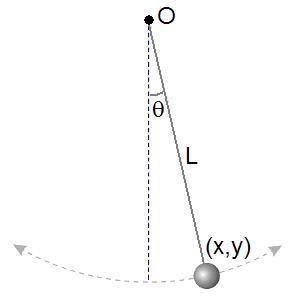 | ||
A mechanical system is scleronomous if the equations of constraints do not contain the time as an explicit variable. Such constraints are called scleronomic constraints.
Contents
Application
Main article:Generalized velocityIn 3-D space, a particle with mass
Velocity is the derivative of position with respect to time. Use chain rule for several variables:
Therefore,
Rearranging the terms carefully,
where
Therefore, only term
Kinetic energy is a homogeneous function of degree 2 in generalized velocities .
Example: pendulum
As shown at right, a simple pendulum is a system composed of a weight and a string. The string is attached at the top end to a pivot and at the bottom end to a weight. Being inextensible, the string’s length is a constant. Therefore, this system is scleronomous; it obeys scleronomic constraint
where
Take a more complicated example. Refer to the next figure at right, Assume the top end of the string is attached to a pivot point undergoing a simple harmonic motion
where
Although the top end of the string is not fixed, the length of this inextensible string is still a constant. The distance between the top end and the weight must stay the same. Therefore, this system is rheonomous as it obeys constraint explicitly dependent on time
